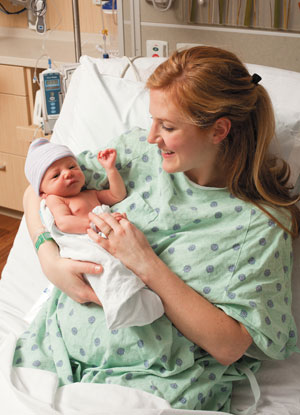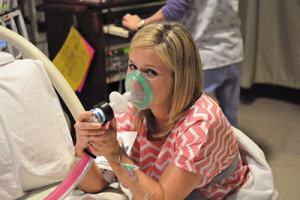By Joan Tupponce

VCU Medical Center’s Labor and Delivery Unit, where Jordyn Matthews gave birth to her son Oxford, advocates a “family-centered” birth experience. Photo by Jay Paul
Giving birth today is far different from how it was back in your grandmother’s day, thanks to technology and improved pain management, as well as a concentrated push toward a more relaxed, family-oriented labor and delivery. Most moms having a low-risk vaginal birth labor and deliver in generously sized, homelike private rooms instead of a stark, nondescript hospital room.
Rumrill, 37, had talked with Dr. Christine Isaacs, an obstetrician and associate professor of obstetrics and gynecology at VCU Medical Center, about her desire to keep the birth experience as intimate as possible. She had planned to have a midwife for the birth, but was referred to Isaacs when it was discovered that her baby was in a breech position and therefore would be delivered via cesarean section. “We were referred to her precisely because she believed in the importance of the baby’s immediate skin-to-skin contact with the mother, even after a C-section,” Rumrill says.
Family Time
Isaacs has pioneered “family-centered” cesarean births at VCU. The experience involves low lights in the OR and piped-in, patient-chosen music via surround-sound Bose speakers. After the birth, the baby is placed on the mom’s bare chest. Rumrill remembers that moment. “She was under warm blankets, skin to skin with me, nursing and holding my finger. It was the happiest moment in my life.”
In the past, mothers often lost that window of opportunity for skin-to-skin contact with the baby directly after birth. “The baby would get whisked off to the nursery, and there was a separation for hours during an emotionally charged time in their life,” Isaacs says. “I started thinking, ‘Why do we do that?’ ”
Isaacs wanted to create an environment in the OR that would reclaim those moments and create a level of intimacy and bonding for the mom and baby. Safety of the mother and baby remains the top priority, however. If there is a hint that something may be wrong, doctors can switch gears instantly. And while the family-centered experience is sought by many mothers, there are some who don’t want it during the C-section. “It’s an opt-in situation,” Isaacs says. “If people are healthy going into it, we offer it.”
Magic Hour
Doctors have discovered that having a mother and baby together immediately after a C-section helps to establish a good breastfeeding relationship, calms the baby, regulates its heart rate and brings the baby’s temperature to where it should be far better than if the baby is wrapped in a blanket and put under a heat lamp. Bringing the newborn to the mom for skin-to-skin contact has been shown to help with initial bonding, says Dr. Janice Gibson-Neale of Manchester OB/GYN and Chippenham and Johnston-Willis hospitals, where “once the baby is born, there is a push toward early bonding with mom and dad. We try to include the family in everything.”

It’s a Gas
What about assistance offered while labor is in progress? Epidurals, which are injected in the lower back to help alleviate the pain associated with childbirth, are still the overwhelming choice for pain management. “It is very rare to have a patient that has complications from the medication,” Gibson-Neale says of epidurals. “Patients are screened for interaction.”
But epidurals aren’t the only choice for pain management now. Bon Secours St. Mary’s Hospital is testing the use of nitrous oxide, commonly known as laughing gas. Nitrous oxide has been used safely during childbirth for more than 50 years. According to a report by the American Society of Anesthesiologists’ Committee on Obstetric Anesthesia, more than half of the women who go into labor in the United Kingdom use nitrous oxide. It is also widely used in Australia, Finland and Canada.
The nitrous oxide blend for childbirth — 50 percent nitrous oxide and 50 percent oxygen — helps to lessen the pain without the numbing effect of an epidural. St. Mary’s is the first hospital in Virginia and one of the few nationwide to offer this option during labor in its trial. If the results are positive, Bon Secours will continue the option at St. Mary’s and offer it at some of its other facilities across the state. “This option is ideal for mothers who want to use their [own] resources as much as possible,” Graf says. “They only need help to get over the peak of contractions.”
Gibson-Neale’s experience is that more and more women are looking at natural childbirth with no medication at all. “It’s a personal choice,” she says, adding, however, that some women who choose natural childbirth may change their minds along the way. “A lot of folks don’t know what to expect. They think they want no medication, but then they get overwhelmed and change their mind when the pains are too bad.”
Waiting Game
In recent years, as demands on women’s time seem to have increased, some have been requesting to have their labor induced on a chosen day, so they can plan ahead. Elective inductions, however, are now being scaled back. “There has been a real emphasis in the medical obstetrics community toward allowing and supporting women to go into labor on their own,” says Dr. Katherine Czyszczon of the Virginia Women’s Center and Henrico Doctors’ Hospital. “We do our best to wait for the onset of labor whenever possible.”
Nonetheless, the number of induced deliveries has increased nationally over the past several years. Babies delivered through induction before 39 weeks of gestation may have to deal with a variety of health risks that would require neonatal intensive care services. And that concerns the obstetric medical community. According to The American College of Obstetricians and Gynecologists (The College), nearly two-thirds of all U.S. hospitals handling non-emergency births have instituted policies to eliminate induced deliveries prior to 39 weeks’ gestation. “In America, [there are more] interventions than anywhere else in the world,” says Graf, of Bon Secours Virginia. “Yes, we can, but should we? We are teaching nurses how to support regular birth.”
To ‘C’ or not to ‘C’
Obstetricians are also pushing for mothers to have vaginal births, if at all possible, rather than C-sections. In 2011, one in three women in the United States gave birth by cesarean delivery, a 60 percent increase since 1996, according to The College. Approximately 60 percent of those births were primary cesareans. This has caused concern that “cesarean delivery is overused without clear evidence of improved maternal or newborn outcomes,” The College says.
“We run into patients who really feel strongly they want to deliver by C-section. It’s not common, but it happens,” says Czyszczon. “We believe in a woman’s rights and her right to plan. It’s not something I would recommend because of the risk with C-section, because it is surgery.”
Supporting Roles
Many women who need extra support during childbirth work with trained, certified doulas. “They are a labor support person,” says Czyszczon. “They use non-medical interventions to cope with pain, and they are a reassurance for mom.”
The ability to manage pain has a lot to do with the anxiety level, which can feed into the pain and make it worse. “That is where the doula comes in,” Czyszczon says. “They are overwhelmingly helpful.”
Appointed by the patient, they are nevertheless accepted — in many cases, recommended — by the hospital’s staff. “The hospital makes a tremendous effort to accommodate whatever the patient desires,” says Czyszczon. “Nurses are amenable and often grateful.” Additionally, at VCU, if patients choose a doula from the School of Nursing’s volunteer doula program, that person will attend a prenatal visit with the patient, support the mother through the baby’s birth and visit the mom and baby at home, postpartum.
New mothers can also benefit from the help of a licensed lactation consultant, who works with the mother and baby after the birth and in the months following. A lot of hospitals “have taken it upon themselves to train labor and delivery nurses and postpartum nurses to be lactation educators,” says Gibson-Neale. “We have seen a great interest in breast feeding.” Czyszczon says that as long as she has been in practice, women have had a strong desire to breastfeed their children, but “what continues to be the challenge is the follow-through. How can we support and encourage that after they leave the hospital?”
Graf notes that Bon Secours has an outpatient lactation center in Innsbrook called A Woman’s Place. “Women can go there for help or call for help.” VCU lactation consultants visit every new mom in the Mother-Infant Unit, monitor a “breastfeeding warmline” and offer a bi-monthly postpartum breastfeeding support group and private outpatient lactation support.
After talking to a relative who had two C-sections in another state, Rumrill feels fortunate that she was able to bond with her daughter immediately. “Both times after the baby was born, she felt completely abandoned,” Rumrill says of her relative. “The baby was immediately taken away for testing and cleaning. She couldn’t even see her until much later. My daughter is 2 years old now, and when I look back at this experience, I still feel the excitement and warmth that surrounded her birth.”
